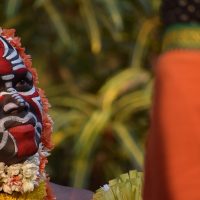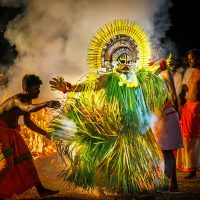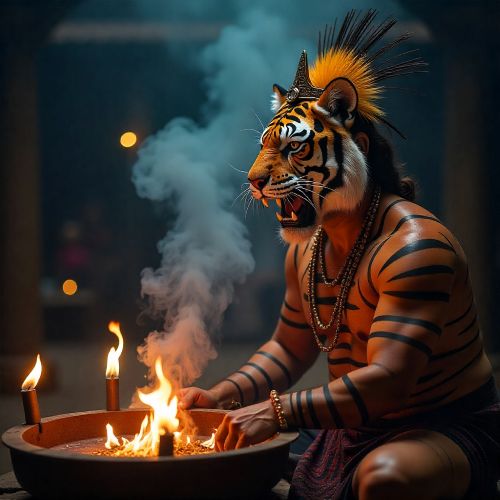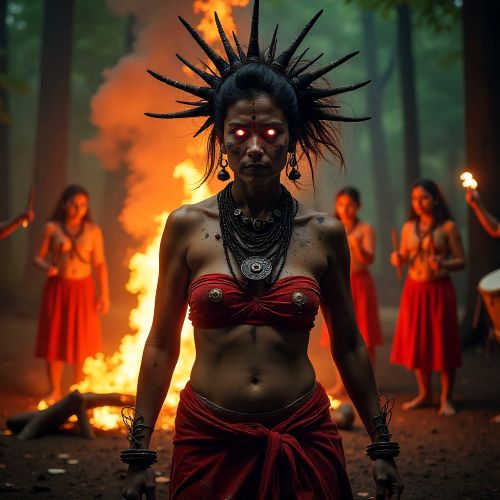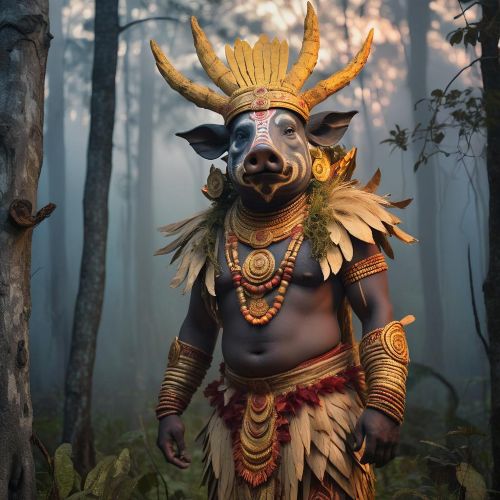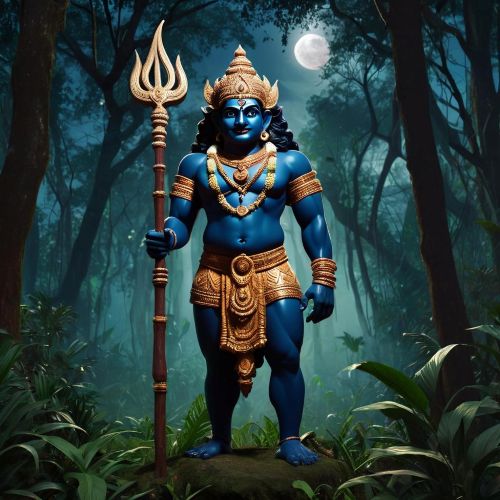Guliga : Guardian of Justice
Listen
At a glance
| Description | |
|---|---|
| Origin | Indian Mythology |
| Classification | Spirits |
| Family Members | N/A |
| Region | India |
| Associated With | Protection |
Introduction
Guliga is one of the most powerful and enigmatic Daivas of Tulu Nadu, a coastal region spanning parts of Karnataka and northern Kerala. Deeply tied to the Bhuta Kola tradition, Guliga is worshipped not as a distant celestial god but as an immediate guardian spirit who safeguards the land, cattle, and communities from harm. The Daivas, unlike the deities of classical Hinduism, are rooted in local ecology and everyday justice, embodying both compassion and wrath. Among them, Guliga stands out as a spirit of primal force—unpredictable, fierce, and revered for his ability to enforce cosmic order. His presence is still alive in ritual practice, oral traditions, and even popular culture, particularly after being vividly represented in the blockbuster Kannada film Kantara, which reintroduced Guliga’s story to a wider audience.
Physical Traits
Guliga is rarely represented through conventional idols or anthropomorphic figures. Instead, he is often symbolized by a rough, uncarved stone placed beneath trees, exposed to the elements. This raw form reflects his untamed energy and direct connection with nature. During Bhuta Kola performances, however, Guliga is embodied by a ritual performer whose appearance is designed to terrify and awe. The impersonator’s face is painted in striking combinations of red, black, white, and green, with bold patterns that accentuate a fierce and otherworldly persona. Palm leaf skirts, anklets, and heavy ornaments complete the costume, while the performance itself involves wild leaps, trance-like movements, and dramatic interaction with fire. The ritual consumption of sacrificial offerings, such as raw chicken or animal blood, intensifies the impression of Guliga as a spirit beyond human control—ferocious yet protective. His physical presence, whether through stone or performance, reinforces his role as both a guardian and a reminder of the primal forces of nature.
Family
The origins of Guliga are steeped in layered myths. One prominent story begins on Mount Kailash, where Goddess Parvati discovers a peculiar stone in a heap of ash and hands it to Shiva. Disinterested, Shiva discards it, and from this stone Guliga emerges, embodying wild energy and insatiable hunger. Lord Vishnu, disturbed by his ferocity, curses him to be born from the womb of a serpent-demoness known as Nelaulla Sanke. His birth is violent—tearing through his mother’s body, leaving destruction in his wake.
Despite these unsettling beginnings, Guliga is not isolated in the spirit world. In many traditions, he is associated with Panjurli, the boar spirit, with whom he shares a complex brotherhood. The goddess Lakshmi or Durga is said to have mediated between them, instructing the two to act as siblings and guardians of justice together. Other traditions describe Guliga as part of a larger spiritual family that includes Chaundi, Jattiga, and Rahu Guliga. These connections highlight his role not as an outsider but as an integral member of the Daiva pantheon, bound to other spirits by kinship and responsibility.
Other Names
The worship of Guliga varies widely across Tulu Nadu, and with it come multiple names and identities. He is often invoked as Kshetrapala, the protector of boundaries and sacred lands. In some shrines, he is known as Hayguliga, while in others, he appears as Rahu Guliga, associated with astrological influences and linked to the shadow planet Rahu. Regional traditions also use titles such as Mantraguliga, Kathale Guliga, Sankale Guliga, and Chawndi Guliga, each reflecting specific attributes, stories, or localized practices. In ritual contexts, he may be referred to as Ambara Marle, a name tied to his frenetic movements during Bhuta Kola performances. These many identities do not dilute his essence but instead emphasize the multifaceted ways in which communities relate to him—as guardian, enforcer, wanderer, and sentinel of justice.
Powers and Abilities
Guliga’s powers are described as both fearsome and protective, embodying the dual nature of destruction and preservation. He is renowned as a punisher of wrongdoers, intervening when justice is denied or social order is broken. Stories portray him as having an insatiable hunger, capable of consuming even celestial bodies like the sun, a metaphor for his uncontrollable force. Yet this hunger is also symbolic of his ability to absorb misfortune, disease, and evil spirits from the community, protecting those under his care.
During Bhuta Kola, when a performer channels Guliga in a state of trance, he is believed to embody the deity’s presence fully. In this state, Guliga listens to disputes, blesses devotees, delivers warnings, and often issues judgments considered binding on the community. Ritual sacrifices—usually chickens—are part of the appeasement, their blood consumed by the impersonator as a symbol of Guliga’s ferocity and appeasement. His role extends beyond mere ritual spectacle; he is considered an active enforcer of Dharma, wielding authority that transcends human law.
Astrological traditions also link Guliga to Gulika Kaal, a time period ruled by Saturn that is considered inauspicious for starting major activities. This association further aligns him with cosmic cycles of discipline, delay, and karmic justice, reinforcing his identity as a spirit tied not only to earthly guardianship but also to universal order.
Modern Day Influences
Despite the passage of centuries, Guliga’s influence in Tulu Nadu remains remarkably strong. Villages continue to organize annual Bhuta Kola rituals where Guliga is invoked, ensuring community harmony and reaffirming ancestral ties. These ceremonies are deeply communal, involving dance, music, and storytelling that bind together spiritual and social life. Even in urbanized areas, shrines dedicated to Guliga can be found, often maintained by marginalized groups who see him as their fierce protector.
The resurgence of interest in Guliga owes much to cinema, particularly the film Kantara (2022), which depicted the ferocity and sacredness of Daiva worship with unprecedented intensity. Through this portrayal, Guliga was reintroduced to audiences far beyond Karnataka, sparking nationwide curiosity about the Bhuta Kola tradition. The film underscored his role as a guardian of land and ecological balance, aligning with contemporary concerns about environmental justice and indigenous rights.
Today, Guliga is not only a figure of myth but also a symbol of resistance against exploitation and disrespect for nature. His worship reflects an ongoing dialogue between tradition and modernity, where ancient rituals continue to inspire cultural identity while offering powerful metaphors for ecological preservation and community justice. In this way, Guliga’s legacy endures—both as a fierce Daiva of Tulu Nadu and as a timeless guardian spirit whose relevance stretches into the modern age.
Related Images
Source
Upadhyaya, U. (2019). Bhuta Worship in Coastal Karnataka: Ritual, Identity, and Resistance. Journal of South Asian Folklore, 12(3), 45–62.
Rao, S. (2015). Spirit Possession and Ritual Performance in Tulu Nadu. In Indigenous Religions of South India (pp. 88–105). Oxford University Press.
Bhat, N. (2017). Daiva Kola: The Living Tradition of Tulu Nadu. Karnataka Folklore Research Institute.
Sharma, A. (2020). Guardians of the Sacred: Kshetrapala Deities in South Indian Traditions. Indian Mythology Quarterly, 18(2), 22–39
Peepul Tree World. (2025). Guliga and Panjurli – The Divine Deities from Kantara. Retrieved from https://www.peepultree.world/livehistoryindia/story/living-culture/the-divine-deities-from-kantara
Times Now News. (2025). Kantara Chapter 1: Who Are Panjurli, Guliga Daiva? Retrieved from https://www.timesnownews.com/entertainment-news/kannada/rishab-shetty-kantara-chapter-1-who-are-panjurli-guliga-daiva-all-you-need-to-know-about-bhoota-kola-myths-realities-article-152932560
Wisdomlib.org. (2024). Guliga: Significance and symbolism. Retrieved from https://www.wisdomlib.org/concept/guliga
AstroVed. (2024). Panjurli – The Divine Deities Of Kantara. Retrieved from https://www.astroved.com/blogs/panjurli-the-divine-deities-of-kantara
Kadri, V. (2025). Story of Guliga. Retrieved from https://vishalbabukadri.blogspot.com/2020/07/story-of-guliga.html
Dharma Pulse. (2025). Who is Guliga? The Fierce Guardian Spirit. Retrieved from https://dharmapulse.com/who-is-guliga-the-fierce-guardian-spirit/
Tulu Research Blogspot. (2015). Early Spirit forms: Guliga, Jattiga, Chaundi, Rahu and Others. Retrieved from https://tulu-research.blogspot.com/2015/04/346-early-spirit-forms-guliga-jattiga.html
Wikipedia. (2023). Buta Kola. Retrieved from https://en.wikipedia.org/wiki/Buta_Kola
Frequently Asked Questions
What is lorem Ipsum?
I am text block. Click edit button to change this text. Lorem ipsum dolor sit amet, consectetur adipiscing elit. Ut elit tellus, luctus nec ullamcorper mattis, pulvinar dapibus leo.
What is lorem Ipsum?
I am text block. Click edit button to change this text. Lorem ipsum dolor sit amet, consectetur adipiscing elit. Ut elit tellus, luctus nec ullamcorper mattis, pulvinar dapibus leo.
What is lorem Ipsum?
I am text block. Click edit button to change this text. Lorem ipsum dolor sit amet, consectetur adipiscing elit. Ut elit tellus, luctus nec ullamcorper mattis, pulvinar dapibus leo.
What is lorem Ipsum?
I am text block. Click edit button to change this text. Lorem ipsum dolor sit amet, consectetur adipiscing elit. Ut elit tellus, luctus nec ullamcorper mattis, pulvinar dapibus leo.
What is lorem Ipsum?
I am text block. Click edit button to change this text. Lorem ipsum dolor sit amet, consectetur adipiscing elit. Ut elit tellus, luctus nec ullamcorper mattis, pulvinar dapibus leo.



